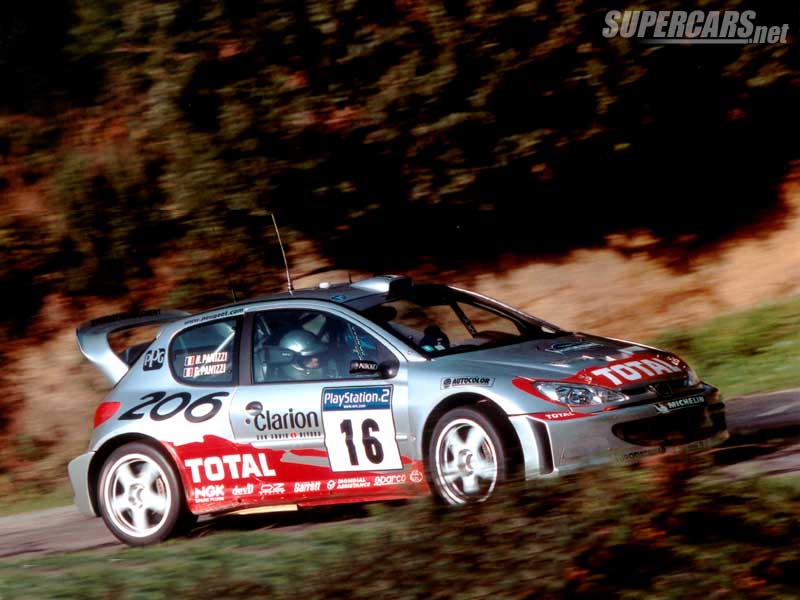2001 Peugeot 206 WRC
The 206 WRC ran for the first time in November 1998, just eleven months after the green light was given by the PSA board for its design, production and entry in the World Rally Championship. The WRC version of the Peugeot 206 shares an undeniable family air with the standard model, but make no mistake, it is packed with technology designed for world-class competition.
Built in accordance with the F.I.A. technical regulations governing the WRC (World Rally Car) category, it features many developments that are even more sophisticated than those found in Formula 1, including all-wheel drive, traction control and electronic differential management, plus a transversely mounted engine coupled to a longitudinal sequential gearbox. Based on a standard shell that is stripped and cut to house its transmission tunnel, chunky, wider wheel-arches and roll-cage, the 206 WRC boasts many high-tech features.
Between six and seven weeks are required to prepare the shell, plus a further two weeks to fit the mechanical assemblies and accessories that will transform it into a full-house competition monster. Its 300 bhp four-cylinder, turbocharged engine comes complete with a post-combustion system that optimises turbo pressure and reduces response time.
Peugeot produces its own shock absorbers for the car and works in close collaboration with Michelin in the field of tyre development with a view to enhancing suspension and traction performance, two vital parameters in rallying. World Rally Cars have not escaped the omnipresence of electronic chips which control the engine, transmission and chassis according to the pressures, temperatures, engine speed, travel and wear rates permanently communicated to the central management unit by sensors.
For its second full World Championship campaign, Peugeot Sport was flown by four works drivers, including two familiar faces : Marcus Grönholm, winner of the 2000 Drivers’ title with the 206 WRC, and Gilles Panizzi, who took the car to two memorable wins in Autumn of 2002.
World Championship 2001 Drivers Richard Burns (44) Colin McRae (42) Tommi Makinen (41) Marcus Grönholm (36) Harri Rovanperä (36)
Manufacturers 1. PEUGEOT (106) 2. FORD (86) 3. MITSUBISHI (69) 4. SUBARU (66) 5. SKODA (17), HYUNDAI (17)
Story by Peugeot
In Detail
| submitted by | Richard Owen |
| engine | XU9J4, Water Cooled, Aluminum Block & Head Inline-4 |
| position | Front Transverse |
| aspiration | Garett TR30R Turbocharger |
| valvetrain | Belt driven OHC, 4 Valves per Cyl |
| displacement | 1997 cc / 121.9 in³ |
| bore | 85 mm / 3.35 in |
| stroke | 88 mm / 3.46 in |
| compression | 8.5:1 |
| power | 223.7 kw / 300.0 bhp @ 5250 rpm |
| specific output | 150.23 bhp per litre |
| bhp/weight | 243.9 bhp per tonne |
| torque | 535 nm / 394.6 ft lbs |
| body / frame | Unit Steel |
| driven wheels | Full Time 4WD |
| front tires | Michelin 20×65/18 |
| rear tires | Michelin 20×65/18 |
| front brakes | Vented Discs w/8-Pot Calipers |
| f brake size | x 355 mm / x 14.0 in |
| rear brakes | Vented Discs w/4-Pot Calipers |
| r brake size | x 330 mm / x 13.0 in |
| front wheels | F 45.7 x 20.3 cm / 18.0 x 8.0 in |
| rear wheels | R 45.7 x 20.3 cm / 18.0 x 8.0 in |
| steering | Power Assisted Rack & Pinion |
| f suspension | MacPherson Struts w/Lower Wishbone, Coil Springs, Gas Shock Abso |
| r suspension | MacPherson Struts w/Lower Wishbone, Coil Springs, Gas Shock Abso |
| curb weight | 1230 kg / 2712 lbs |
| wheelbase | 2468 mm / 97.2 in |
| front track | 1534 mm / 60.4 in |
| rear track | 1534 mm / 60.4 in |
| length | 4005 mm / 157.7 in |
| width | 1770 mm / 69.7 in |
| height | 1300 mm / 51.2 in |
| transmission | Longitudinal X-Trac 6-Speed Sequential w/Triple Plat 6 inch Clut |
| gear ratios | :1 |







